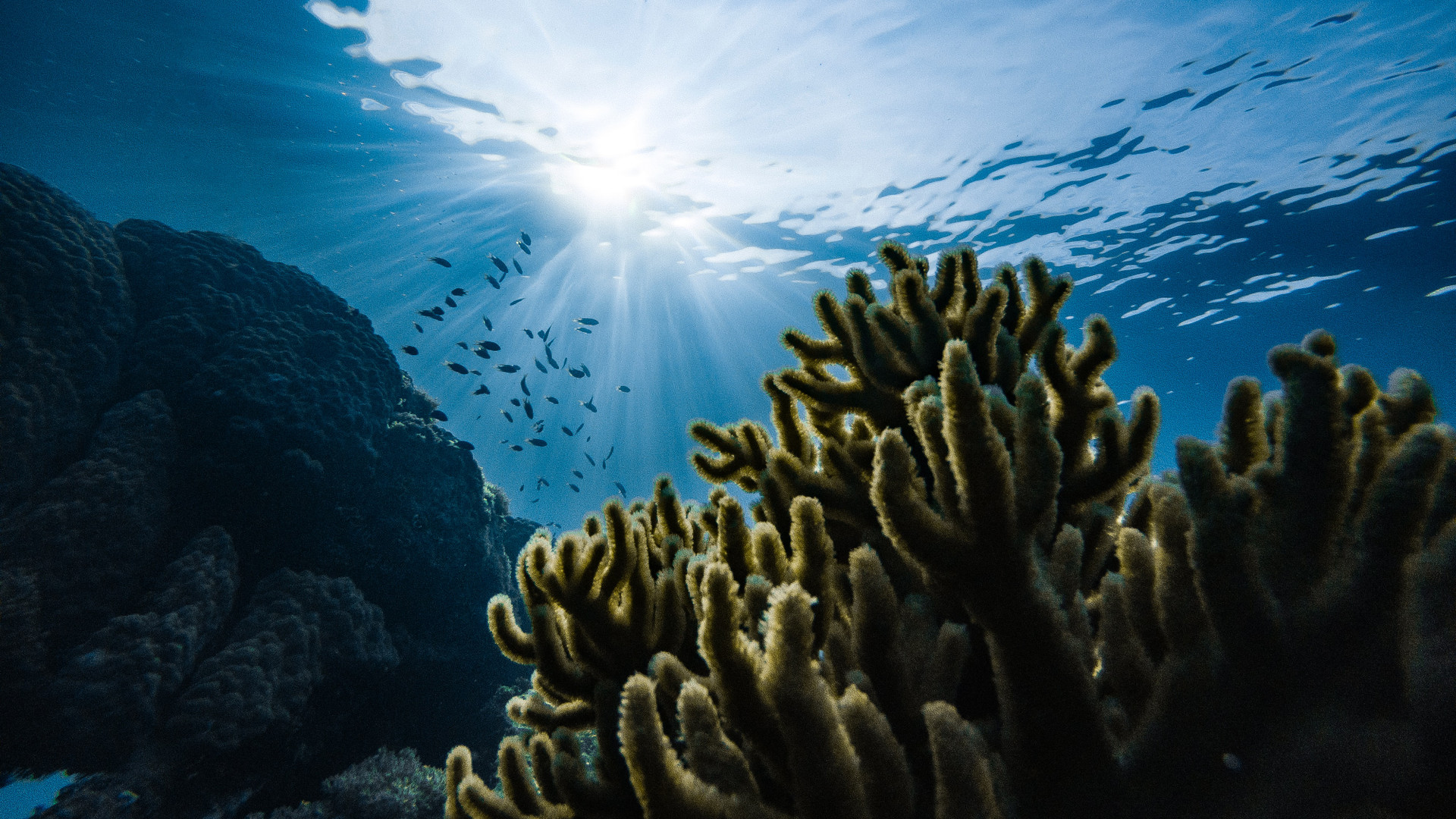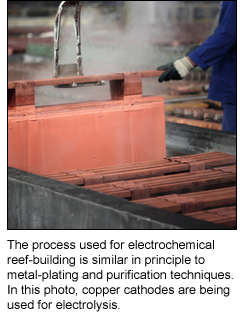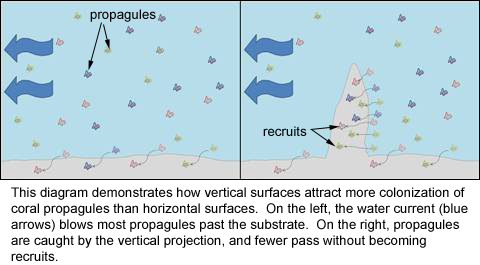Electricity and the Reef, A Shocking Way to Repair Coral Ecosystems PART 1

WARNING: Do not mix electricity and water. Doing so will lead to serious injury or death. The following article is in no way a recommendation to attempt the scientific endeavors described herein.

Corals are amazing, plain and simple! For animals that are so non-complex that they do not even possess organs, corals manage to hide a world of secrets from inquiring minds. I, possessing such an inquiring mind, recently came across a topic I just had to know more about. Several news pieces about electrified reefs caught my attention, and I began to research the physiology and chemistry behind the idea. To my surprise, I discovered that this idea was not as new as I had previously believed. In this multi-part article, I will describe the process by which electricity is believed to enhance coral growth, as well as the current and future applications of this profound discovery.
My first introduction to the idea of electrified reefs was through a short news blurb that gave few details about the process. As a marine aquarist, I was captivated by the idea that something as commonplace, and dangerous, as electricity would be able to enhance coral growth to such a phenomenal degree. Naturally, I was not satisfied with just knowing that it happens; I had to know why. Looking deeper into the subject, I found out that there are still some things that are not understood about the bio-chemical processes that occur during coral growth. It seems that not all corals are impacted by electricity in the same way, nor are corals the only organisms affected. Moreover, electrified reefs are not just about coral growth. They are about the rapid recovery potential offered to damaged coral ecosystems.

The History of Artificial Reefs
It all started with oceanic reef repair. As most people know, tropical and cold-water reefs are areas of extreme importance. Not only do they add to the overall diversity of the ocean, they also create natural breakwaters and habitat areas for species of economic importance. Fish, corals, sponges, live rock, and coral sand are all harvested in some capacity. Thus reefs are ecologically and economically significant. Over time, a number of forces have combined to degrade reefs all over the globe. Sources of degradation include bottom-trawl fishing, ships running aground, overharvesting of livestock for food and ornamental purposes, SCUBA and snorkel traffic, nutrient-laden run-off, rising sea levels, and extreme wave and weather conditions. Just this year, a severe inundation of cold water caused large-scale die-offs on Caribbean and Florida reefs. Moreover, travesties like the current oil spill in the Gulf of Mexico paint a frightening prognosis for the future of hard-bottom communities in the ocean.
Records of artificial reefs date back to the early 1800s, where Japanese fisherman used bamboo and other materials to create them. These artificial reefs likely functioned as Fish Aggregating Devices (FAD) to make fishing easier. In recent decades, governments and conservation groups have begun to take a real interest in the restoration of reefs. In the 1950s, the idea was to plant artificial structures made of concrete and a variety of other materials on soft-bottoms, in order to enhance the capacities of local fisheries. Large ships were cleansed of oil and sunk, concrete rip-rap was placed haphazardly, and people began to dump things of no ecological value like tires and train cars. These artificial reef materials often contributed significant amounts of toxins and other pollutants to the environments they were intended to enhance. As late as the 1970s, the use of fly ash cement was being proposed as a cheaper alternative, in spite of its highly toxic nature.
Fortunately, the previous two decades have seen a new set of ecologically-minded principles arise. Studies released in the last few years have shed light on the intrinsic economic value of global tropical reefs, which is estimated to exceed $130,000 to $1.2 million per hectare, annually. As such, the emphasis on more natural restoration processes began to take hold, leading researchers to explore more novel methods of reef restoration. New materials were put into use, such as plastic, fiberglass, steel, and safer hydraulic cement. Nonetheless, many of these newer reefs developed slowly, or not at all. Then, in 1977, a brand new restoration method was developed that was completely different than anything ever done in the past.
Making Something Out of Nothing
Scientist Wolf Hilbertz and his team created a technique that utilized electricity to enhance coral growth on artificial reefs. They did so in response to low colonization of previously placed artificial reefs. The colonization failure was thought to be a combination of unsuitable materials and poor vertical profiles. By using electricity, Hilbertz was able to draw ions directly from seawater to create calcium rich rocks. The process, called accretion, was similar to what happened on its own in the ocean. It differed, however, in one significant waythe artificial process was much faster.
In order to understand the way that accretion works, it is first necessary to understand a little bit about how electricity works. Unfortunately, by its very nature electricity is elusive; it can be created in numerous ways that sometimes seem to be spontaneous. Technically, electricity is defined as the movement of charged subatomic particles. However, the most common particle in question is the electron. Electrons will flow from an area of negative charge to an area of positive charge, via a particular pathway. In general, there are two ways electricity is transmitted. In a direct current (DC), such as that created by a battery, the electrons always flow in single direction. Unlike DC, in alternating current (AC), which is the type of electricity in your house, electrons can flow in either direction. When a circuit between the positive source and the negative source is completed, electricity will flow and create a current. Anywhere that ions of like charge can be separated from those of opposite charge creates a voltage potential, or the possibility for an electrical current to develop. In electronic devises, the pathway is created using metal. In the atmosphere, on the other hand, clouds can separate charged particles, creating voltage potential that leads to lightning. Amazingly, the oceans ionic salts, called electrolytes, enable electrical conductivity as well.
When electricity is applied to a seawater in specific way, an electrolysis reaction occurs, which acts to concentrate the desired electrolytes near one of the electrodes. What happens is similar to the process that goes on in electroplating and metal purification. Ions are drawn toward the cathode, where they are reduced. During reduction, they give up electrons to the circuit and bond together, come out of solution, and form tough precipitates that encrust hard surfaces. Such surfaces include the cathode itself, as well as other objects within the electric field. At the other end of the circuit is an anode, where different ions accept the electrons, and are thereby oxidized. Through oxidation-reduction reactions such as this, it is possible to quickly turn the oceans natural electrolytes into a hard, suitable substrate for coral colonization.
Though many elements occur in the ocean, it is the presence of a certain selection of electrolytes, especially calcium and magnesium, which is responsible for the bio-accretionary processes that marine invertebrates and algae use to create hard skeletons and shells. Without these ions, organisms would not have access to the raw materials they need to create their tough calcareous parts. Near the cathode, the electrolyte solution becomes very alkaline and the pH increases. At the same time, the area around the anode is acidic, and the pH is lower. This pH differential explains why growth happens near the cathode and not the anode. Elevated alkalinity is believed to assist hard corals with calcium deposition, though most of the evidence to that effect is anecdotal. There is, however, some scientific data that corroborates the anecdotes. Conversely, acidic conditions are known to weaken and even dissolve carbonate precipitates (if the circuit were reversed, the accreted material would indeed dissolve away from the cathode-turned-anode).
Making carbonate precipitates from seawater requires multiple chemical reactions to occur sequentially. First, water (H2O) and carbon dioxide gas (CO2) combine to form carbonic acid. Dissolved calcium ions (Ca(2+)) immediately replace the protons (H+) in carbonic acid molecules, creating solid aragonite (calcium carbonateCaCO3). The protons combine together with electrons to create hydrogen gas (H2), which bubbles out of the system. In a similar reaction, water molecules are broken into protons and hydroxide ions (OH-) by magnesium ions (Mg(2+)). Solid magnesium hydroxide (bruciteMg(OH)2) and hydrogen gas are the byproducts of this reaction. Around the cathode, and within the electrical field, brucite and aragonite are rapidly precipitated out of solution, acting to encrust localized objects with a hard covering of these substances.

Coming Up, PART 2
In PART 2, the basic construction and numerous benefits of electric reefs are explored.
Works Cited:
Borell, E.M., S.B.C. Romatzki, and S.C.A Ferse. Differential Physiological Responses of Two Congeneric Scleractinian Corals to Mineral Accretion and An Electrical Field. Coral Reefs, Vol. 29. pp. 191-200. 2010.
Borneman, E.H. and J. Lowrie. Advances in Captive Husbandry and Propagation: an Easily Utilized Reef Replenishment Means from the Private Sector. Bulletin of Marine Science, 69:2. pp. 897-913. 2001.
Collins, T. What are Coral Reef Services Worth? $130,000 to $1.2 million per Hectare, per Year. Oct. 16, 2009. URL: < http://www.eurekalert.org/pub_releases/2009-10/d-... >
Delmendo, M. N. A Review of Artificial Reefs Development and Use of Fish Aggregating Devices (Fads) in the Asean Region. Symposium on Artificial Reefs for Management of Marine Resources. May, 1990.
Hilbertz, W. and T. Goreau. Third Generation Artificial Reefs. Ocean Realm Magazine. Oct. 1997. Accessed via Global Coral Reef Alliance Online. URL: < http://www.globalcoral.org/third_generation_artif... >
Hilbertz, W. and T. Goreau. United States Patent: Method of Enhancing the Growth of Aquatic Organisms, and Structures Created Thereby. U.S. Patent Number 5,543,043. Aug. 1996.
Hilbertz, W.H. The Electrodeposition of Minerals in Sea Water for the Construction And Maintenance of Artificial Reefs. Artificial Reefs: Proceedings Of A Conference Held September 13-15, 1979 In Daytona Beach, Florida. pp. 123-148. 1981.
M.G. Sabater and H.T. Yap. Growth and Survival of Coral Transplants with and without Electrochemical deposition of CaCO3. Journal of Experimental Marine Biology and Ecology, 272:2. pp. 131-146. 2002.
Precht, W.F. (editor). Coral Reef Restoration Handbook. CRC Press: Boca Raton. 2006.
Riggs, B., F. Perez, and T. Goreau. The Electric Reef. 2007. URL: < http://www.timespub.tc/2007/01/the-electric-reef/... >
Schuhmacher, H., P. van Treeck, M. Eisinger, and M. Paster. Transplantation of Coral Fragments from Ship Groundings on Electrochemically Formed Reef Structures. Proceedings 9th International Coral Reef Symposium, Bali, Indonesia, Vol. 2. October 2000.
Siboni, N., et al. Conditioning Film and Initial Biofilm Formation on Electrochemical CaCO3 Deposition on a Metallic Net in the Marine Environment. Biofouling, 25:7. pp. 675-683. Oct. 2009.
Silberberg, M.S. Chemistry; the Molecular Nature of Matter and Change, Third Edition. McGraw Hill: Boston. 2003.
Staff. Electrochemical Reef Construction (ERCON). University of Essen Institute for Ecology. 2004. URL: < http://www.uni-due.de/nomatec/themen_ercon_inhalt... >
Yap, H. T., R. M. Alvarez, H. M. Custodio III, and R. M. Dizon. Physiological and Ecological Aspects of Coral Transplantation. Journal of Experimental Marine Biology and Ecology, 229:1. pp. 69-84. 1998.
Yap, H.T. and M.G. Sabater. Long-term effects of induced mineral accretion on growth, survival and corallite properties of Porites cylindrica Dana. Journal of Experimental Marine Biology and Ecology, 311:2. pp. 355-374. 2004.
Zievis, C.J. Enhanced Growth of the Scleractinian Coral Porites rus Through Elevated Alkalinity. Master of Science Thesis, University of Maine. Dec. 2005.
Photo Credits:
Kwok, R., L.D. Groot, and D. Fleschler. Global Coral Reef Alliance. Sun Sentinel: AP. 2009.